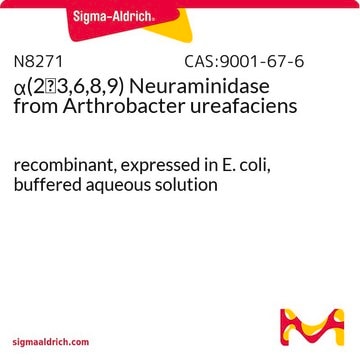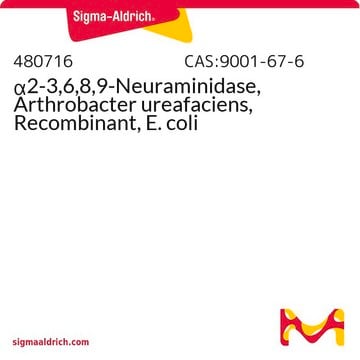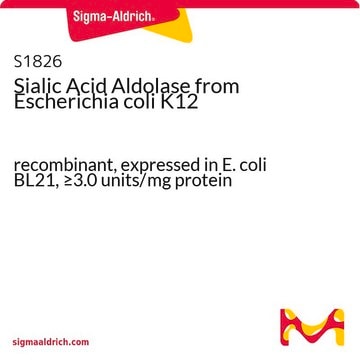N3786
α(2→3,6,8,9) Neuraminidase from Arthrobacter ureafaciens
Proteomics Grade, suitable for MALDI-TOF MS
Sinónimos:
Neuraminidase from Arthrobacter ureafaciens, Acyl-neuraminyl Hydrolase, Sialidase
About This Item
Productos recomendados
Formulario
lyophilized powder
Nivel de calidad
calidad
Proteomics Grade
actividad específica
≥25 U/vial
idoneidad
suitable for MALDI-TOF MS
temp. de almacenamiento
2-8°C
¿Está buscando productos similares? Visita Guía de comparación de productos
Categorías relacionadas
Aplicación
Envase
Calidad
Definición de unidad
Forma física
Los componentes del kit también están disponibles por separado
- N3536Neuraminidase 5X Reaction Buffer 1.5 mLSDS
Producto relacionado
Palabra de señalización
Danger
Frases de peligro
Consejos de prudencia
Clasificaciones de peligro
Resp. Sens. 1
Código de clase de almacenamiento
11 - Combustible Solids
Clase de riesgo para el agua (WGK)
WGK 1
Punto de inflamabilidad (°F)
Not applicable
Punto de inflamabilidad (°C)
Not applicable
Elija entre una de las versiones más recientes:
Certificados de análisis (COA)
¿No ve la versión correcta?
Si necesita una versión concreta, puede buscar un certificado específico por el número de lote.
¿Ya tiene este producto?
Encuentre la documentación para los productos que ha comprado recientemente en la Biblioteca de documentos.
Los clientes también vieron
Artículos
Glycan Sequencing Using Exoglycosidases
Learn about O-linked glycan strategies, O-glycosidase actions, how to remove sialic acid residues, β-Elimination, and O-glycan modifications.
Understand sialic acid structure, function, signaling, and modifications. Easily find products for sialic acid research.
Nuestro equipo de científicos tiene experiencia en todas las áreas de investigación: Ciencias de la vida, Ciencia de los materiales, Síntesis química, Cromatografía, Analítica y muchas otras.
Póngase en contacto con el Servicio técnico









